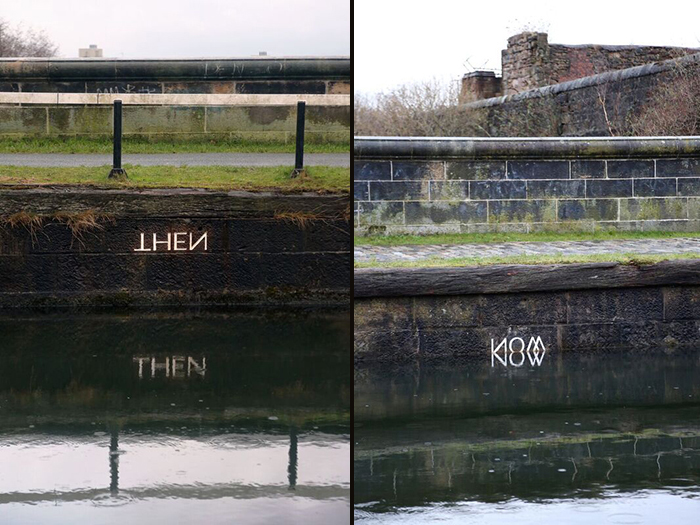Forth and Clyde Canal artworks unveiled
Published: 25 January 2016
New public art installations will be unveiled along the Forth and Clyde Canal this weekend. The University of Glasgow's Dr Minty Donald is involved.
New public art installations will be unveiled along the Forth and Clyde Canal this weekend, paying tribute to the waterway’s industrial heritage and the role it plays today.
The artworks, installed at intervals along the canal side, reflect the many industries the canal once served as well as celebrating its changing modern day role as a recreational space and ribbon of regeneration.
The work also highlights the changing status of the canal, with its connections to other waterway networks and uses materials to mirror the canal’s rich history: iron, stone and water.
Three artists Neil McGuire, Nick Millar and the University of Glasgow’s Dr Minty Donald were commissioned for the pieces and they will unveil their work ‘THEN/NOW ‘at a special event being held at The Whisky Bond in Glasgow on Saturday.
Dr Minty Donald, commenting on 'THEN/NOW', said: “The project has allowed us to learn about and experience different facets of the Forth and Clyde Canal – as it is today and how it operated in the past.
“It was built for a very specific purpose to move goods as a passageway between the two coasts east and west of Scotland, but that role had been redundant since the 1950s but it’s also now become a very vibrant area where people walk, run and cycle so its purpose has taken a new direction.
“The pieces of art are enduring, they are permanent pieces of art but like the canal itself they will change with the seasonal conditions and the weather. People often think of sculpture as static, fixed and permanent, it doesn’t change but these works are designed to change and age over time.
“We met and worked with a wide range of people and communities who are involved with the canal, studying historic drawings and maps with Scottish Canal’s archivists and taken a field trip with a canal worker who travels 100 miles each day to monitor and manage the water levels.”
On a section of the canal wall the artists have carved the word ‘THEN’ and on the opposite side the word ‘NOW’. The ‘THEN’ which is above a waterline and the ‘NOW’, on the water line refers to when the canal was used as an industrial transport route. When the canal was in industrial use the water level was much higher to enable large vessels to move along the route, but the canal was decommissioned in 1963 and the water level was deliberately lowered to make it easier for maintenance.
The project was partly commissioned by Scottish Canals, along with Scottish Waterways Trusat and Glasgow Sculpture Studios.
Richard Millar, Director of Heritage, Enterprise and Sustainability at Scottish Canals, said: “Built more than 200 years ago as a transport artery that stoked the fires of the Industrial Revolution, the Forth and Clyde Canal has no shortage of stories to tell.
“This project has brought a wealth of activity to the Forth and Clyde, from the water to its banks and beyond, and we hope the artworks will encourage even more people to explore the many wonders of the canal in the future.’
As part of the project filmmaker Christopher Quinn filmed a barge pulling event where a heavy horse, a group of children, six cyclists and a team of kayakers, pulled a timber-laden canal barge in a two minute time trial. The 15 minute film will be on show at the launch on Saturday.
The project also built a temporary furnace on the site of the former Victoria Iron Foundry, adjacent to the canal, where scrap iron was heated to 1400 degrees centigrade and the molten iron poured into hand-crafted iron ingots, which sporadically line the banks of the canal.
Nine granite boulders, reclaimed from a Scottish Canal’s work yard, are prominent features and are aligned to represent the mapping of the canal across central Scotland.

For more information contact Jane Chilton at the University of Glasgow Communications and Public Affairs Office on 0141 330 3535 or email jane.chilton@glasgow.ac.uk
First published: 25 January 2016
<< January
Related links:

